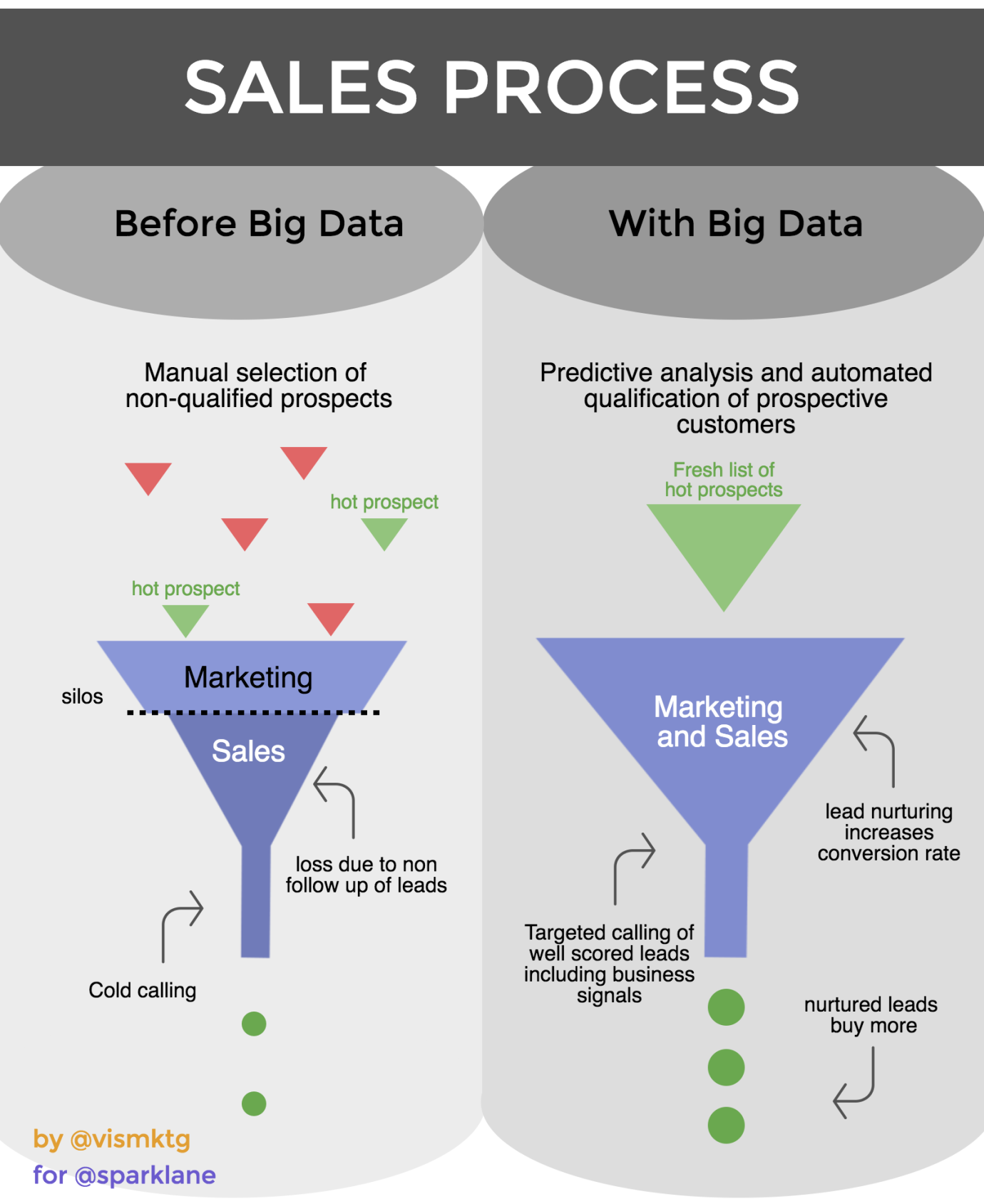24 March 2021
60% of salespeople assisted by AI and automation by 2021
AI and automation will be a staple of the B2B sales processs according to Forrester. Sales Enablement is booming in the US,…
2 April 2020
Big Data is having increasing influence on how companies do business. Perhaps unsurprisingly, the mass of data has led to some roles being changed and the clear lines of responsibility being blurred. This is particularly evident in marketing and sales functions.
In the past, businesses have recognised the importance and structure of the sales funnel and, internally, sales and marketing were distinct operations – both of which were reliant on the success of the other. However, Big Data has led to a marketing and sales crossover and the extension of the classic Sales Funnel to include elements that were traditionally seen as marketing.
As marketing and sales professionals work closer and closer together, often seamlessly providing support and information to each other, businesses are seeing Big Data and predictive sales analytics as crucial to their sales and marketing efforts. As a matter of fact, access to internal and external data is now fairly straightforward for all businesses, and the question is no longer whether data is or isn’t available. The focus has therefore shifted to the analysis and use of this data. Only businesses which have solved that issue will be successful.
This topic is central to a forthcoming white paper by Sparklane entitled How Sales Intelligence is Transforming B2B Sales, which will be available later on in October 2016.

Using Sales Intelligence from the very start of the funnel is a major focus for the vast majority of B2B sales and marketing departments. Fortunately, it’s also an area where Big Data can be of great help. However useful, many businesses still have to implement Sales Intelligence and namely lead scoring techniques.
In addition to publically available Sales Intelligence about prospects – from data about their business to information about the individual gleaned from public social networks such as LinkedIn, for example – every business will already hold a range of data about existing customers which, whenever necessary, can be supplemented by external data. Mixing existing and acquired data, businesses can profile particular types of leads and customers both via their profile information and according to their behavioural patterns and their likely interests and needs and potential to order.

Lead scoring is familiar to many B2B marketers and sales professionals and, despite being extremely effective, research suggests that only 40% of businesses are using the lead scoring tools that their marketing automation provides with only 7% using predictive lead scoring –this is despite the fact that 74% of B2B marketers have identified lead quality as a top issue for them. Whereas traditional lead scoring is done by coming up with a list of criteria that the sales or marketing departments think fit the likely profile of a customer, predictive lead scoring uses algorithms along with both internal and external data to model the similarities between new leads and existing customers.
Big Data and Sales Intelligence are also powerful allies in sales messaging. Using segmentation algorithms, prospects can be assigned into groups so that they can be guided or receive hyper-targeted campaigns, providing highly relevant information about products and services that have already proved effective with existing customers of the same persona. This approach is particularly useful in today’s complex multichannel B2B environment where messages can, otherwise, become lost.
Once they have been converted from prospect to customer, new avenues open up which use predictive data to increase sales income and business efficiency. These include:
Optimising Sales Calls – data collection and modelling can predict behaviours and reactions in individual B2B customers. For instance, some customers may be working in a business environment that makes them react particularly negatively to calls but positively to email
marketing. As well as the individual’s past responses, industry and demographic data may point to which contact methods are effective and when they are most effective. Making contact at the right time and in the right way makes the customer less resistive and more receptive.
Perfecting Service & Support – predictive data analysis can help understand current needs and predict future customer issues and support requirement levels. This allows for the efficient use of resources internally along with being able to pre-empt customer requirements, thereby providing an excellent service and the ongoing relationship benefits that this provides.
Maximising Income – for businesses which sell services that include a renewal element, predictive modelling can help reduce churn and increase income. It does this by identify various customer types based on existing customer profiles. Customer types may include those who are likely to renew in almost any event, those who are unlikely to renew and, crucially, those who would renew only if an incentive were offered. This is a clear area where predictive analytics can save money and improve the bottom line as they can offer renewal incentives exclusively to those customers who need them and not those who would renew at full price anyway.
The internet provides potential B2B customers with a wealth of information about possible suppliers before the sales teams are contacted. Sales Intelligence allows sales and marketing departments to redress the balance and have a real insight into the potential customer, their business, their likely behaviours and needs. Simply put, predictive analytics and Big Data represent the most significant development in marketing and sales in the past thirty years. They deliver concrete results in sales, marketing and business efficiency which positively impact the bottom line. As Big Data and Sales Intelligence are now more accessible than ever, there really is no reason for businesses to miss out.
This topic is central to a forthcoming white paper by Sparklane entitled How Sales Intelligence is Transforming B2B Sales, which will be available later on in October 2016.